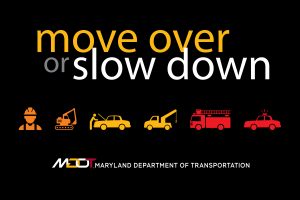
GLEN BURNIE, MD (May 5, 2022) – As motorists travel this Mother’s Day weekend, the Maryland Department of Transportation (MDOT), state and local law enforcement officials and the National Highway Traffic Safety Administration (NHTSA) ask one simple question: Would you move over or slow down if it was your mother on the side of the road?
For law enforcement officers, roadside workers, utility crews and tow truck drivers, one of the most dangerous parts of their job is being on the side of the road for a traffic stop, to assist a motorist, to fix a portion of the road or to investigate a crash. To help protect those who protect us, MDOT is urging everyone to embrace the meaning behind the national “Move Over” awareness campaign. Between May 8 and May 17, MDOT Motor Vehicle Administration’s (MDOT MVA) Highway Safety Office is providing law enforcement agencies with overtime grants for speed and move over violation enforcement, as well as posting educational messages on social media.
“Many drivers seem to think moving over is just an optional courtesy when they see law enforcement or emergency vehicles on the side of the road,” said MDOT MVA Administrator Chrissy Nizer, who also serves as Governor Larry Hogan’s Highway Safety Representative. “But it’s not optional. Please move over when you see those flashing emergency lights. It’s the law, and it saves lives.”
Maryland Driver’s Understanding of the Move Over Law
According to the results of a recent Road Safety Behaviors and Attitudes study conducted on behalf of MDOT MVA’s Maryland Highway Safety Office, many Maryland drivers lack true knowledge of the state’s Move Over laws. Drivers surveyed were told Maryland has several Move Over laws that govern when vehicles should move over or slow down for vehicles parked on the shoulder.
When presented with a list of seven types of vehicles and asked to identify which the Move Over laws apply to, only 1% of those surveyed chose these four correct answers and no others:
- emergency vehicles (ambulance, fire truck, police);
- tow trucks;
- utility trucks; and
- Department of Public Works vehicles (sanitation trucks, snowplows, etc.).
Forty-two percent of those surveyed choose all the correct answers, but also chose vehicles not included in the law. Emergency vehicles was the most frequently selected correct answer at 90%, while vehicles that were in a crash was the most frequently selected incorrect answer at 71%.
Once the Move Over laws were explained, those surveyed were asked what speed they would slow down to if the speed limit was 55 mph, and they were in a situation where the Move Over laws would apply. More than two-thirds indicated they would slow down to a speed of 45 mph (24%), 40 mph (25%) or 35 mph (20%). However, roadside workers and law enforcement officers say it doesn’t feel like motorists are slowing down.
“Unfortunately, police officers and other highway workers are still at risk from drivers who do not move over or slow down,” Maryland Transportation Authority (MDTA) Police Chief Col. Kevin M. Anderson said. “Almost every officer can remember a scene where a vehicle failed to move over and passed within inches of them at highway speeds. Our safety is dependent on drivers doing the right thing – moving over when possible or slowing down to a speed that will keep everyone safe.”
In 2021, two MDTA Police Officers were struck and injured by drivers who did not move over. Thankfully, both officers have returned to duty after surgery and rehabilitation. Both of these crashes were preventable.
“The men and women working on our roadways are first responders. They’re out there serving the public – many times working in hazardous conditions to render aid to people who really need help,” MDOT Secretary James F. Ports said. “It’s not too much to ask that we move over or slow down. These officers, crews and utility workers are out there making sure we get home safe every day. We can return the favor by protecting them as well.”
Expansion of Maryland’s Move Over Law
Every state has Move Over laws requiring drivers to move over and/or slow down when approaching stopped emergency vehicles with emergency lights activated. In Maryland, the law was originally enacted in October 2014 requiring motorists to move over for emergency vehicles, law enforcement vehicles and tow trucks. In 2019, the law was expanded to include service vehicles such as transportation, service and utility vehicles, as well as waste and recycling trucks that have their lights flashing.
Based on a recent bill (SB0147) Maryland’s Move Over law will expand once again on October 1, 2022. The expanded law will require a driver to make a lane change or slow the speed of their vehicle when approaching from the rear any stopped, standing or parked vehicle displaying hazard warning lights, road flares or other caution signals including traffic cones, caution signs or non-vehicular warning lights. The expanded law is aimed toward protecting all road users.
Motorists who encounter a roadside emergency, such as a flat tire, are encouraged to find a safe place to stop – ideally far away from travel lanes and to use caution and common sense – because every incident is unique. More information and a 60-second education video about “What to do in a Roadside Emergency” can be found at ZeroDeathMD.gov/RoadsideSafety .
Learn more about MDOT MVA’s Highway Safety Office’s commitment to zero deaths on Maryland roadways at ZeroDeathsMD.gov and on Facebook, Twitter and Instagram at zerodeathsmd.
###